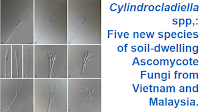Truffles, Tuber spp., are Ascomycote Fungi which from ectomycorrhizal relationships with a range of forest Plants, including Pines, Oaks, Hickories, and Orchids. They are distinguished for their large, tuber-like ascomata (fruiting bodies), which are formed underground, which often have highly distinctive aromas and flavours, leading to some species being traded as high-value gourmet items.
There are currently 25 species of Truffle known from Mexico, mostly from the temperate forests of the north and the mountains of the Neovolcanic axis. However, none of these are currently traded as foodstuffs, despite Mexico a globally leading countries in terms of the number of edible wild Fungi consumed, with about 500 species, making it second only China, where about 1000 are consumed. However, recent efforts have found that the non-native Black Truffle, Tuber melanosporum, will form ectomycorrhizal relationships with native Mexican Oaks, and several species found in Mexico are considered to have potential for commercial development, including the Pecan Truffle, Tuber lyonii, which is commercially exploited in the US and Canada, and can trade for up to US$400 per kg.
In a paper published in the journal Phytotaxa on 26 January 2024, Javier Isaac de la Fuente of the Colegio de Postgraduados at Campus Montecillo, Wendy Rosales-Rosales of the Instituto Tecnológico Superior de Zongolica of the Tecnológico Nacional de México, César Romero Martínez-González of the Instituto Tecnológico de Ciudad Victoria of the Tecnológico Nacional de México, Magdelana Martínez-Reyes, also of the Colegio de Postgraduados at Campus Montecillo, Andrea Carolina Elizondo-Salas, also of the Instituto Tecnológico Superior de Zongolica of the Tecnológico Nacional de México, and Jesús Pérez-Moreno, agian of the Colegio de Postgraduados at Campus Montecillo, describe a new species of edible Truffle from the Coniferous mixed forests of eastern Mexico.
The new species is named Tuber itzcuinzapotl, where 'itzcuinzapotl' means 'Dog's Zapote' in the Nahua language (a Zapote is a type of fruit). This Truffle produces subglobose fruiting bodies with a light brown, verrucous-granular outer surface, and an gray or pale brown interior, reaching up to 28 mm by 28 mm in size, with a distinctive fruity taste and smell. It is found growing in association with Mexcan Weeping Pines, Pinus patula, in Veracruz State, Mexico.
Mexico has a significant culture of wild Fungus consumption, with over 500 types of Fungi consumed by members of all ethnic groups, and in particular rural communities living close to woodland. However, almost all consumed Fungi are epigeal, i.e, found above the ground, such as Mushrooms, with very little exploitation of subterranean species occurring. This is surprising, as Mexico is one of the most biodiverse regions in the world for Oaks, and Oaks are particularly associated with Fungi producing underground fruiting bodies.
Tuber itzcuinzapotl is known to be consumed by members of the Nahua ethnic group living in the Sierra de Zongolica region of Veracruz State, Mexico, where it is referred to as 'itzcuinzapotl' (the specific name chosen for the species). Local folklore has it that people began to consume these Fungi after observing Dogs digging them up and eating them. Knowledge of the Fungus appeared to be restricted to older women in the community. Such local knowledge of wild foodstuffs is considered to be at risk in the region as traditional cultures are eroded, leading to loss of knowledge and a reduction and homogenisation in the number of foodstuffs consumed by Humans both in Mexico and globaly.
See also...









